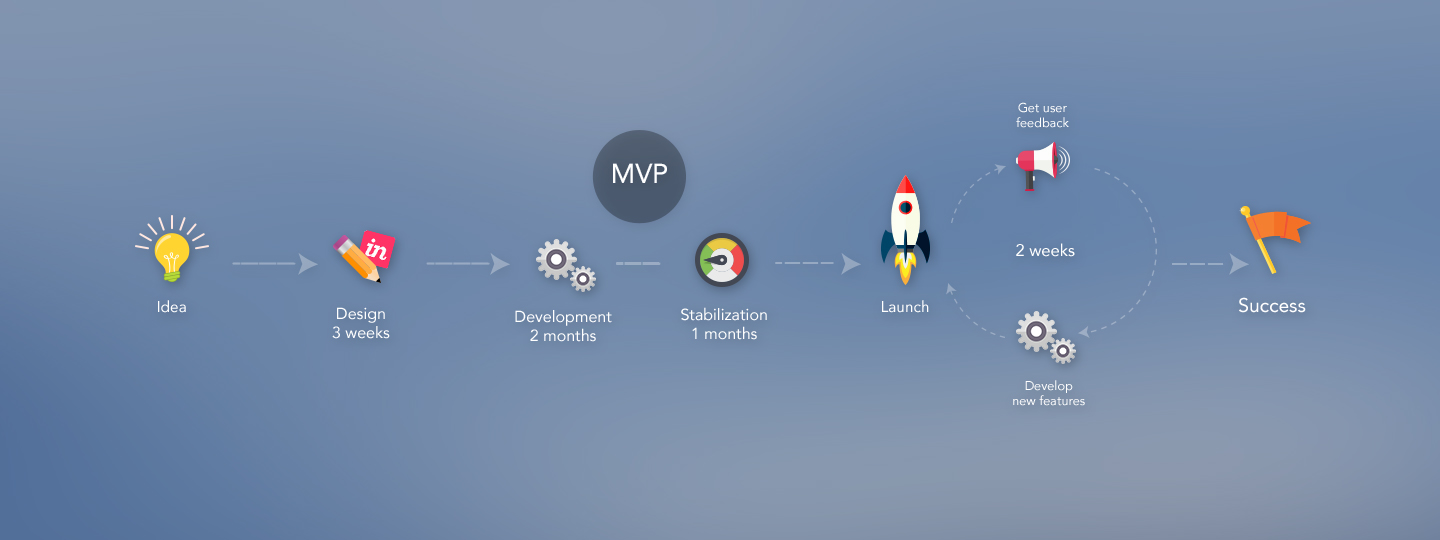How to increase your startup success chances?

The biggest goal for any startup team is to actually finish its product and release it – there are many projects that are too ambitious right from the start.
It ’s quite common when a small team is trying to create something huge that would take thousands of hours to develop. Eventually, the project fails and remains unfinished because of all those unnecessary additional features.
But it’s not only about being too ambitious. There are plenty of other reasons why startups fail to release their project without exceeding their budgets and deadlines:
- Insufficient research. The team did not conduct a proper marketing research. As a result, the team gets a useless product that no one wants to use.
- It’s too late. The team has exceeded the deadlines while developing additional features. In the meantime, fast competitors have managed to release their product earlier.
- Low price. Cheap and good quality product. It can’t be achieved in 95% of cases. Most likely you’ll have to find new developers to fix the mess that was made by unprofessional developers. At best you get an expensive product with mediocre quality.
- Open Source. Usage of open source solutions. Don’t get us wrong! Open source solutions are great for cutting some development expenses (you don’t have to develop something that has been already developed). But we all must know when to stop – it’s impossible to create a unique product while using only open source solutions.
There are a few methods that can help you to avoid all those issues mentioned above. One of them is the Lean Startup methodology. Let’s talk about it and what opportunities it provides.
The essence of Lean Startup
The methodology itself is based on japanese car industry practices (japanese car companies know really much about rational resources usage). There are few key concepts in lean startup. One of them is MVP – minimum viable product.
MVP means that only vital features will be developed in the first place, and all those “would-be-great-to-have” features will be postponed until the project’s post-release support.
According to MVP methodology, the team splits the project into the following stages:
- Goal setting combined with thorough market research. Well-detailed goal/requirements description can greatly simplify the development process and save your precious time on coordination processes.
- Idea visualization. A designer creates the product’s prototype so that both the client and development team can understand what to do next, and what the product should look like at the end of the development cycle. In most cases, it takes 2-3 weeks to create a prototype (the price is usually fixed).
- Product development – 2 months with two-weeks iterations. With this approach it becomes really easy to track the project’s progress (you get new build every two weeks).
- QA and stabilization – Product polishing, bugfixing, small features implementation (internal analytics, “Rate our app”-popups, etc.) – 1 month.
- Product launch followed by user feedback analysis.
Lean Startup helps to:
- Do first things first. Any successful application must have its “killer feature” – the one that makes users want to use your app. All those additional features are great, but they are not necessary for the product launch.
You can compare them with… Additional car features. We can use a car if it’s missing climate control, audio system or even windshield. We can also use a car if there’s no shower inside (well, most of us). But the car is pretty useless if there’s no engine or wheels, right?
So, the basic “startup car” looks like this: a beautiful car with a great audio system, seat heaters, panoramic roof… But also with a broken engine and two wheels left.
The team was too concentrated on additional stuff, so there is no budget left for fixing main features (therefore product launch is impossible). Eventually, the team has either to shut down the project or to find additional financing (which is often impossible).
- Create scalable system Any business should have growth potential (user base growth, new markets entry). If your project is client-server based, you have to check if your servers can withstand high load.
- Launch on time. Provide simultaneous work of both development and marketing teams. Common misconception – product development consumes most of the project’s budget. Development expenses usually equal 30% of the total project’s budget.
The other 70% are operational and marketing expenses. With that kind of approach, it’s better to start your marketing campaign and user feedback analysis as soon as possible.
Feedback helps your product to become better and can define the direction of the project’s future development. Keep analyzing user feedback even if your project launch was a success. After its release, the product can be improved during a few two-week iterations. This is the way how the product can become what users want it to be.
Next, your development team can start long-term project support by adding new features and improving what has been already developed. In the Japanese car industry, there is a term for this process – “Kaizen” (activities that continuously improve all project’s features.)
Short development cycle combined with quick product launch can provide information about product’s weak points and various mistakes that were made during initial planning. This information can be used for a pivot (direction change).
Pivot-type may vary depending on which challenges that your project has to face (economical or legal issues). The lean startup allows you to minimize your development budget so your team can use more resources for resolving those issues.
The main point of lean startup is that project should be “small but good quality” instead of being “big but not ready for launch”. Thus lean startup allows you to:
- Try out your ideas with minimum expenses;
- Get information required for potential pivot as soon as possible (impossible to get without product launch)
- Get user feedback for product improvement.
There are plenty of big companies that started with lean startup – Quora, TechCrunch, Dropbox, Pinterest, PayPal, etc. Of course, this does not mean that lean startup guarantees the success of any project, but it sure can improve your chances.
